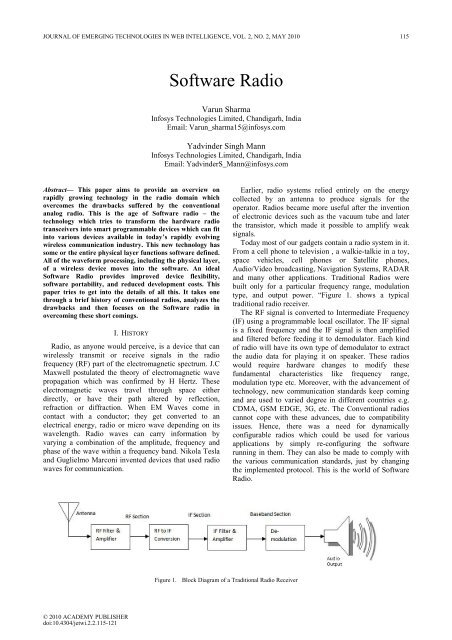Journal of Emerging Technologies in Web Intelligence Contents
Journal of Emerging Technologies in Web Intelligence Contents
Journal of Emerging Technologies in Web Intelligence Contents
You also want an ePaper? Increase the reach of your titles
YUMPU automatically turns print PDFs into web optimized ePapers that Google loves.
JOURNAL OF EMERGING TECHNOLOGIES IN WEB INTELLIGENCE, VOL. 2, NO. 2, MAY 2010 115S<strong>of</strong>tware RadioVarun SharmaInfosys <strong>Technologies</strong> Limited, Chandigarh, IndiaEmail: Varun_sharma15@<strong>in</strong>fosys.comYadv<strong>in</strong>der S<strong>in</strong>gh MannInfosys <strong>Technologies</strong> Limited, Chandigarh, IndiaEmail: Yadv<strong>in</strong>derS_Mann@<strong>in</strong>fosys.comAbstract— This paper aims to provide an overview onrapidly grow<strong>in</strong>g technology <strong>in</strong> the radio doma<strong>in</strong> whichovercomes the drawbacks suffered by the conventionalanalog radio. This is the age <strong>of</strong> S<strong>of</strong>tware radio – thetechnology which tries to transform the hardware radiotransceivers <strong>in</strong>to smart programmable devices which can fit<strong>in</strong>to various devices available <strong>in</strong> today’s rapidly evolv<strong>in</strong>gwireless communication <strong>in</strong>dustry. This new technology hassome or the entire physical layer functions s<strong>of</strong>tware def<strong>in</strong>ed.All <strong>of</strong> the waveform process<strong>in</strong>g, <strong>in</strong>clud<strong>in</strong>g the physical layer,<strong>of</strong> a wireless device moves <strong>in</strong>to the s<strong>of</strong>tware. An idealS<strong>of</strong>tware Radio provides improved device flexibility,s<strong>of</strong>tware portability, and reduced development costs. Thispaper tries to get <strong>in</strong>to the details <strong>of</strong> all this. It takes onethrough a brief history <strong>of</strong> conventional radios, analyzes thedrawbacks and then focuses on the S<strong>of</strong>tware radio <strong>in</strong>overcom<strong>in</strong>g these short com<strong>in</strong>gs.I. HISTORYRadio, as anyone would perceive, is a device that canwirelessly transmit or receive signals <strong>in</strong> the radi<strong>of</strong>requency (RF) part <strong>of</strong> the electromagnetic spectrum. J.CMaxwell postulated the theory <strong>of</strong> electromagnetic wavepropagation which was confirmed by H Hertz. Theseelectromagnetic waves travel through space eitherdirectly, or have their path altered by reflection,refraction or diffraction. When EM Waves come <strong>in</strong>contact with a conductor; they get converted to anelectrical energy, radio or micro wave depend<strong>in</strong>g on itswavelength. Radio waves can carry <strong>in</strong>formation byvary<strong>in</strong>g a comb<strong>in</strong>ation <strong>of</strong> the amplitude, frequency andphase <strong>of</strong> the wave with<strong>in</strong> a frequency band. Nikola Teslaand Guglielmo Marconi <strong>in</strong>vented devices that used radiowaves for communication.Earlier, radio systems relied entirely on the energycollected by an antenna to produce signals for theoperator. Radios became more useful after the <strong>in</strong>vention<strong>of</strong> electronic devices such as the vacuum tube and laterthe transistor, which made it possible to amplify weaksignals.Today most <strong>of</strong> our gadgets conta<strong>in</strong> a radio system <strong>in</strong> it.From a cell phone to television , a walkie-talkie <strong>in</strong> a toy,space vehicles, cell phones or Satellite phones,Audio/Video broadcast<strong>in</strong>g, Navigation Systems, RADARand many other applications. Traditional Radios werebuilt only for a particular frequency range, modulationtype, and output power. “Figure 1. shows a typicaltraditional radio receiver.The RF signal is converted to Intermediate Frequency(IF) us<strong>in</strong>g a programmable local oscillator. The IF signalis a fixed frequency and the IF signal is then amplifiedand filtered before feed<strong>in</strong>g it to demodulator. Each k<strong>in</strong>d<strong>of</strong> radio will have its own type <strong>of</strong> demodulator to extractthe audio data for play<strong>in</strong>g it on speaker. These radioswould require hardware changes to modify thesefundamental characteristics like frequency range,modulation type etc. Moreover, with the advancement <strong>of</strong>technology, new communication standards keep com<strong>in</strong>gand are used to varied degree <strong>in</strong> different countries e.g.CDMA, GSM EDGE, 3G, etc. The Conventional radioscannot cope with these advances, due to compatibilityissues. Hence, there was a need for dynamicallyconfigurable radios which could be used for variousapplications by simply re-configur<strong>in</strong>g the s<strong>of</strong>twarerunn<strong>in</strong>g <strong>in</strong> them. They can also be made to comply withthe various communication standards, just by chang<strong>in</strong>gthe implemented protocol. This is the world <strong>of</strong> S<strong>of</strong>twareRadio.Figure 1. Block Diagram <strong>of</strong> a Traditional Radio Receiver© 2010 ACADEMY PUBLISHERdoi:10.4304/jetwi.2.2.115-121
















